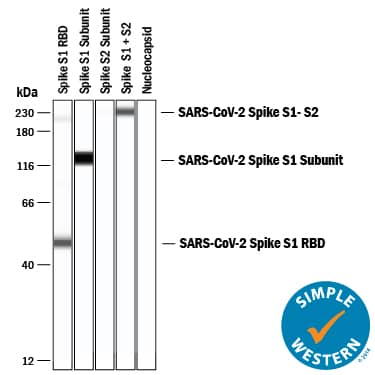SARS-CoV-2 Spike RBD Antibody
R&D Systems, part of Bio-Techne | Catalog # MAB105401

Key Product Details
Species Reactivity
Validated:
SARS-CoV-2
Cited:
Human, Primate - Cercopithecus aethiops (African Green Monkey)
Applications
Validated:
Simple Western, Western Blot
Cited:
Immunocytochemistry, Western Blot
Label
Unconjugated
Antibody Source
Monoclonal Mouse IgG2B Clone # 1034515
Product Specifications
Immunogen
Recombinant SARS-CoV-2 Spike Protein, S1 Subunit, Receptor Binding Domain (RBD)
Arg319-Phe541
Accession # YP_009724390
Arg319-Phe541
Accession # YP_009724390
Specificity
Detects SARS-CoV-2 Spike Protein S1 Receptor Binding Domain (RBD) in direct ELISAs and Western blots. Detects SARS-CoV-2
B.1.1.529 S RBD (Omicron Variant) in direct ELISAs
Clonality
Monoclonal
Host
Mouse
Isotype
IgG2B
Scientific Data Images for SARS-CoV-2 Spike RBD Antibody
Detection of SARS-CoV-2 Spike RBD by Western Blot.
Western blot shows recombinant SARS-CoV-2 Spike RBD protein. PVDF membrane was probed with 2 µg/mL of Mouse Anti-SARS-CoV-2 Spike RBD Monoclonal Antibody (Catalog # MAB105401) followed by HRP-conjugated Anti-Mouse IgG Secondary Antibody (HAF018). A specific band was detected for SARS-CoV-2 Spike RBD at approximately 35 kDa (as indicated). This experiment was conducted under reducing conditions and using Western Blot Buffer Group 1.Detection of SARS-CoV-2 Spike RBD by Simple WesternTM
Simple Western lane view shows recombinant SARS-CoV-2 Spike S1 RBD (receptor binding domain) protein, recombinant SARS-CoV-2 Spike S1 subunit protein, recombinant SARS-CoV-2 Spike S2 subunit protein (negative sample), recombinant SARS-CoV-2 Spike S1/S2 subunit protein, and recombinant SARS-CoV-2 Nucleocapsid protein (negative sample), loaded at 0.2 mg/mL. Specific bands were detected for SARS-CoV-2 Spike S1 RBD at approximately 50kDa, SARS-CoV-2 Spike S1 subunit at approximately 129kDa, and SARS-CoV-2 Spike S1/S2 subunit at approximately 230kDa (as indicated) using 20 µg/mL of Mouse Anti-SARS-CoV-2 Spike RBD Monoclonal Antibody (Catalog # MAB105401) . This experiment was conducted under reducing conditions and using the 12-230 kDa separation system.Applications for SARS-CoV-2 Spike RBD Antibody
Application
Recommended Usage
Simple Western
20 µg/mL
Sample: Recombinant SARS-CoV-2 Spike S1 RBD (receptor binding domain) protein, Recombinant SARS-CoV-2 Spike S1 subunit protein, and Recombinant SARS-CoV-2 Spike S1 /S2 subunit protein
Sample: Recombinant SARS-CoV-2 Spike S1 RBD (receptor binding domain) protein, Recombinant SARS-CoV-2 Spike S1 subunit protein, and Recombinant SARS-CoV-2 Spike S1 /S2 subunit protein
Western Blot
2 µg/mL
Sample: Recombinant SARS-CoV-2 Spike RBD protein
Sample: Recombinant SARS-CoV-2 Spike RBD protein
Formulation, Preparation, and Storage
Purification
Protein A or G purified from hybridoma culture supernatant
Reconstitution
Reconstitute at 0.5 mg/mL in sterile PBS. For liquid material, refer to CoA for concentration.
Formulation
Lyophilized from a 0.2 μm filtered solution in PBS with Trehalose. *Small pack size (SP) is supplied either lyophilized or as a 0.2 µm filtered solution in PBS.
Shipping
Lyophilized product is shipped at ambient temperature. Liquid small pack size (-SP) is shipped with polar packs. Upon receipt, store immediately at the temperature recommended below.
Stability & Storage
Use a manual defrost freezer and avoid repeated freeze-thaw cycles.
- 12 months from date of receipt, -20 to -70 °C as supplied.
- 1 month, 2 to 8 °C under sterile conditions after reconstitution.
- 6 months, -20 to -70 °C under sterile conditions after reconstitution.
Background: Spike RBD
References
- Wu, F. et al. (2020) Nature 579:265.
- Tortorici, M.A. and D. Veesler (2019). Adv. Virus Res. 105:93.
- Bosch, B.J. et al. (2003) J. Virol. 77:8801.
- Belouzard, S. et al. (2009) Proc. Natl. Acad. Sci. 106:5871.
- Millet, J.K. and G. R. Whittaker (2015) Virus Res. 202:120.
- Yuan, Y. et al. (2017) Nat. Commun. 8:15092.
- Walls, A.C. et al. (2010) Cell 180:281.
- Jiang, S. et al. (2020) Trends. Immunol. https://doi.org/10.1016/j.it.2020.03.007.
- Ortega, J.T. et al. (2020) EXCLI J. 19:410.
- Wrapp, D. et al. (2020) Science 367:1260.
- Tai, W. et al. (2020) Cell. Mol. Immunol. https://doi.org/10.1016/j.it.2020.03.007.
- Okba, N. M. A. et al. (2020). Emerg. Infect. Dis. https://doi.org/10.3201/eid2607.200841.
- Wang, X. et al. (2020) https://doi.org/10.1038/s41423-020-0424-9.
- Wang, K. et al. (2020) bioRxiv https://www.biorxiv.org/content/10.1101/2020.03.14.988345v1.
Long Name
Spike Receptor Binding Domain
Gene Symbol
S
UniProt
Additional Spike RBD Products
Product Documents for SARS-CoV-2 Spike RBD Antibody
Product Specific Notices for SARS-CoV-2 Spike RBD Antibody
For research use only
